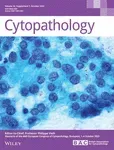Cytopathology Journal
The Official Journal of the British Association for Cytopathology and an Affiliated Journal of over 20 National Cytology Societies
Read Cytopathology
The aim of Cytopathology is to publish articles relating to those aspects of cytology which will increase our knowledge and understanding of the aetiology, diagnosis and management of human disease. It contains original articles and critical reviews on all aspects of clinical cytology in its broadest sense: including gynaecological and non-gynaecological cytology, fine needle aspiration and screening strategy. The Journal welcomes papers on ultrastructural, histochemical and immunocytochemical studies of the cell as well as articles on quantitative cytology and DNA hybridization as applied to cytological material.
Editorial policy reflects the interest of cytopathologists and cytotechnologists alike as well as the interests of clinicians using the cytology service. It also reflects the interest of biological scientists whose work involves research at the cellular level.
Mina Desai Early Career Investigator Award
2023 awardee splitting the Early career award equally between:
Delfim Doutel Molecular characteristics of low-grade serous carcinoma in effusions
Sebastian Manuel Milluzzo for Rapid on-site evaluation improves sensitivity of endoscopic ultrasound-guided fine needle aspiration (EUS FNA) for solid pancreatic lesions irrespective of techniques: a single-center experience
Mina Desai Award for Research Excellence winners
2023 awardee is Jan Philipp Kühnand Dual Sec62/Ki67 immunocytochemistry of liquid-based cytological preparations represents a highly valid biomarker for non-invasive detection of head and neck squamous cell carcinomas
2022 awardee is Abed Zaitoun: The Role Of Cytology In The Investigation And Management Of Pancreatobiliary Lesions With A Transition Towards A Standardised Reporting System: An Institutional Perspective
Congratulations for your excellent work from the BAC.
Previous award winners can be seen here.
Cytopathology Social Media Team #CytoJ
Christina Zioga - Greece
Jamal Musayev - Azerbaijan
Maja Kebe - Slovenia
Leonie Wheeldon - UK
Joshua Li - China
Swati Sattuwar - USA
Varsha Manucha - USA
